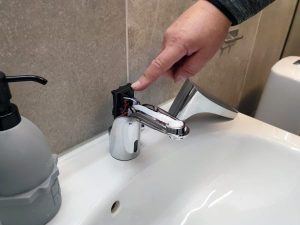SUSTAINABLE HOUSING. Housing Solutions for the future are being tested in real-time in the KTH Live-In Lab testbed platform. Four students live in Testbed KTH, which consists of apartments equipped with the latest technology. Among other things, the apartments are fitted with connected mixers from FM Mattsson, which track the students’ water use. “This is a unique way of helping to develop smart homes,” says Frank Rälg, Product Manager – Smart Products, FM Mattsson.
The students moved into the apartments in the autumn of 2018. Everything in the apartments – from air and ventilation to moisture and water – can be monitored and tested with the help of connected sensors. The project aims to make it easier for the construction sector to utilise new technologies.
– It’s important to aid the development of smarter, more sustainable buildings. To succeed with this, we need to get faster at testing new technology. Our solution is to use real-life testbeds where companies and researchers work together to test technologies in real systems, says Jonas Anund Vogel, Director, KTH Live-In Lab.
Smart water savings
Water use also needs to be monitored. FM Mattsson’s 9000E Tronic mixers are equipped with sensors and connect wirelessly to a cloud service. The data generated by the mixers helps residents to monitor their water use. The data can also be used by other actors such as property owners and developers to detect usage patterns, enabling them to save energy and money.
– Keeping track of how much, and when, water is used makes it easier to optimise the hot water supply. If nobody is at home, no hot water needs to be generated in that home at that time. Every little contribution adds up to save resources, Jonas emphasises.
The students also provide valuable feedback about the mixers, which has helped the FM Mattsson Mora Group to optimise its products.
– This is an excellent environment for testing new solutions. The students are quick to give feedback, for instance, if the shower emits water for too long or too short a time. This allows us to optimise the settings in line with their needs. This generation of users are also very conscious about saving resources, says Frank
Cooperating with others
Technical solutions from about 70 different companies are used in the testbeds. The more solutions and systems there are to coordinate, the more important cooperation becomes.
– In a connected society, companies must work together to create multiple benefits for residents. Actors that might have been rivals in the past are now cooperating. Systems have to be open in order to work, explains Jonas.
– Those of us who are involved in the project are seeking ways to make our different systems work together. It’s valuable for us to interact and try out new techniques to make things even more efficient,says Frank.
How do you expect smart homes to develop in the future?
- More and more functions in homes will be connected. The question is what the developments will be and what form they will take. People are getting tired of having a separate app for each service. Instead of 35 different apps, I think there will ultimately just be one app for every home. Or no app at all. In the future, a home’s smart heat pump might communicate with its smart mixer without the user being involved at all. That’s when things will start getting really smart, says Frank.
– I like having technology, but I don’t like seeing it. And I think many people share this view. I believe smart homes will offer one choice. The user will choose one setting. Then the building will take care of itself, and after a few weeks, it will have tailored its operations to the user’s living patterns. On a national level, I think smart buildings will communicate with each other in the future. By distributing system loads, we’ll be able to optimise our resource use, minimise emissions and stop building new gas-fired power plants, concludes Jonas.

